Summer Squash Lasagna
Y’all, it’s been another crazy week, and I’ve only had time to type up one recipe. But it’s one of my personal favorites: Lasagna!
I love lasagna. It’s so versatile and forgiving and, well, delicious. I know some people find it overwhelming to make, but I find the required organization and layering therapeutic. Weird? Maybe. But, seriously, I love it.
It wasn’t too hard to make lasagna when I was vegetarian. I mean, noodles, sauce, veggies, cheeses. Right? But when I quit dairy, I had to figure out how to recreate the creamy ricotta layers. I experimented with many substitutions, and tried just about every vegan cheese on the market, but it took a few tries to get the texture where I wanted it.
Result: a light, creamy, healthy, plant-based lasagna that won’t leave you feeling greasy, fat, or bloated. And it’s delicious.
I’ve been making various seasonal versions of this lasagna for a few years. It’s flexible like that. In the fall and winter, it’s great with thin sweet potato layers. In the spring, swiss chard or spinach. In the summer my favorite additions are summer squash and basil.
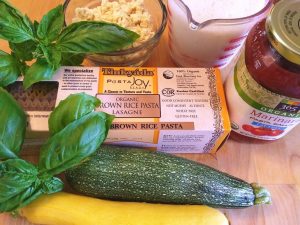
Of course, you can get real fancy with lasagna and make your own pasta and sauce. I’ve done that. But, really, there are so many great jarred sauces, I just use store-bought sauce 99% of the time. Easy.
I made this batch of lasagna with organic gluten-free rice noodles. Use whatever lasagna noodles you like. The rice noodles aren’t an integral part of the recipe.
In place of the ricotta, I used crumbled firm tofu. I used about 1/2 of a block of extra-firm organic tofu. The key to using tofu is to make sure you’ve removed as much water as possible. There are several ways to do this: you can press it or drain it. I think the texture is best when I freeze it, thaw it, and then press it. Yes, that’s a bit of work, but I eat a lot of tofu, and I usually keep a good bit in the freezer, so it’s ready to thaw and use as needed. (I cut the blocks in quarters, freeze it on a plate, and then, once frozen, store the frozen tofu cubes in zippy freezer bags).
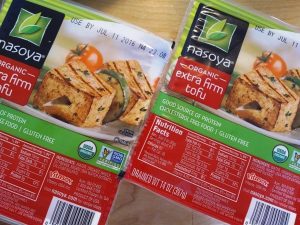
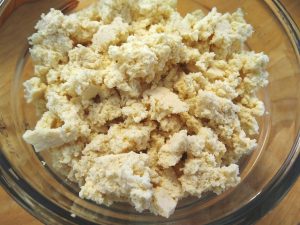
Obviously, if you’re averse to tofu (or on a soy free diet), skip this. Use dairy or non-dairy ricotta. (Kite Hill makes a really good almond based ricotta, but it’s only available at Whole Foods, so I don’t use it much).
My favorite lasagnas, back in my dairy-days, were the ones with both tomato sauce *and* bechamel or alfredo layers. Seriously, who doesn’t love a cream sauce?
For this lasagna, I made a cream sauce out of cashews. (Shocking, I know). It’s super-simple and really takes the lasagna up a notch. The sauce is thin (like milk) when it comes out of the blender, but it thickens up tremendously when the lasagna bakes. Trust me on this.
The cashew cream sauce is easy. You put all the ingredients into the blender (I used my Vitamix), and then blend, blend, blend. It doesn’t look very appetizing before you blend it, but, once it’s all blended and cooked, you will be a believer, too. (And, of course, if you don’t want to use cashews, then use your favorite home-made or store-bought bechamel or alfredo sauce!).
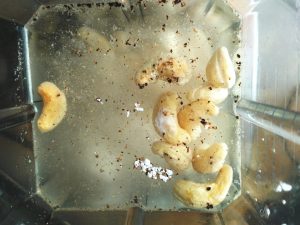

While I’m making the cream sauce, cooking the noodles, and dealing with the tofu, I like to bake the very thinly sliced squash in a low oven for about 15 minutes to slightly dehydrate it. This helps ensure the squash is soft and, most importantly, keeps the lasagna from being too wet. If you use raw squash in the lasagna, I can’t vouch for the results. (But, based on my past experimentation, I’m gonna bet your lasagna won’t set right).
I used two trays of yellow squash and zucchini. You’ll see I used a metal cooling rack over an old cookie sheet for dehydrating the squash; it helps the air flow underneath so that they really dry out. The top picture is the raw squash, and the bottom one is the slightly dehydrated veggies. You can see that they aren’t browned at all, but are slightly shrunken.
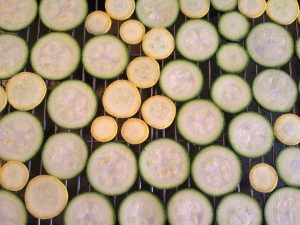
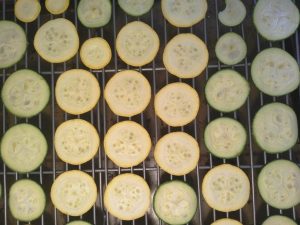
While all the above is going on, don’t overcook your noodles! If anything, leave them slightly undercooked, because they will continue to soften while the lasagna is in the oven.
Once the noodles are cooked and drained, the squash is slightly dehydrated, the tofu is crumbed, and the cream sauce is made, it’s time to assemble!
I used a glazed ceramic casserole dish for the lasagna. It’s about 8″ x 11.5″; I don’t think the size of the pan is critical. Just aim for something close.
I sprayed my dish with a very, very light coating of organic olive oil spray. Then I started layering. The first layer is always tomato sauce. After that, noodles and then the fillings. Over and over, ending with noodles and sauce on the top. (And if you must have stretchy cheese on top, throw on a handful of mozzarella or some non-dairy shreds. I never liked the top, greasy cheese layer, so I didn’t stress too much about trying to recreate that here).
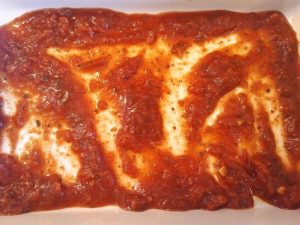
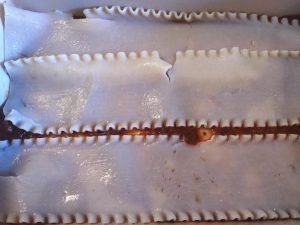
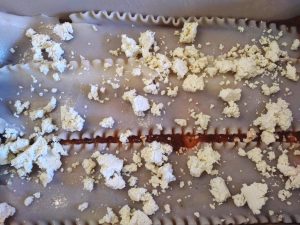
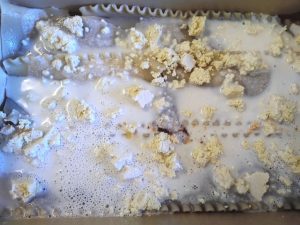
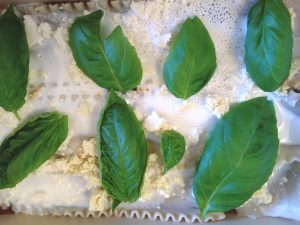
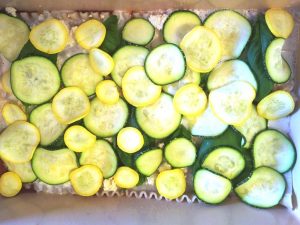
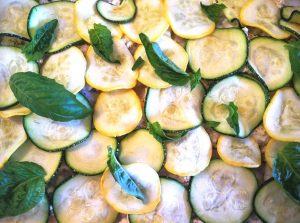
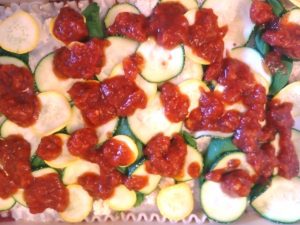
I ended up with 3 layers of tofu/cream sauce/squash/basil and 4 layers of noodles and sauce (because you start with sauce+noodles and end with noodles topped with sauce). In total, I used 12 lasagna noodles and the entire jar of pasta sauce.
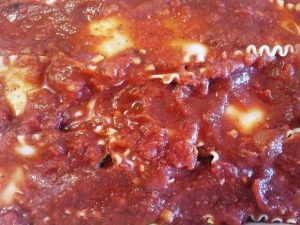
I bake this lasagna “low and slow” at 350 degrees for 50-55 minutes. This ensures that the squash is adequately cooked and that the sauces have had time to “set.” I also let the lasagna rest for about 10-15 minutes before I serve it.
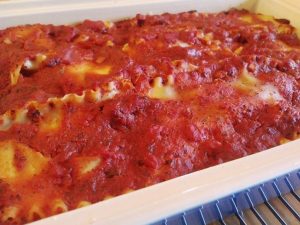
We enjoyed this lasagna with grilled eggplant. It would also be delightful with a healthy green salad.
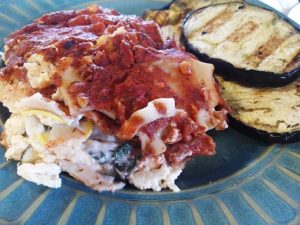
- 2 squash or zucchini
- 1 jar (25oz) pasta sauce
- 2 c cream sauce
- 10 oz lasagna (12 noodles)
- 1 1/2 c crumbed tofu
- several fresh basil leaves
- 2/3 c raw cashews
- 2 c water
- 1 tbsp cornstarch
- pinch of garlic powder
- pinch of nutmeg
- salt + pepper
- Preheat the oven to 300 degrees F.
- Thinly slice squash (and/or zucchini) using a mandoline or sharp knife. Arrange squash slices on metal racks over old cookie sheets. Fill two cookie sheets with a single layer of squash and bake, at 300, for about 15 minutes until the squash is slightly dehydrated.
- After you remove the squash from the oven, bump the temperature up to 350 degrees F.
- If you're making the cashew cream sauce, put all the ingredients in a blender, and blend until smooth. You may need to scrape down the sides of the blender jar once or twice. Taste once blended and adjust seasoning. (I like for the sauce to be a little salty with a clear hint of nutmeg). The sauce will be very, very thin (like milk).
- Cook pasta according to package directions. Do not overcook.
- Once the cream sauce is ready, the pasta is cooked, and the squash are out of the oven, start layering your lasagna in a lightly-greased casserole dish.
- Start with sauce on the bottom, then a layer of pasta (probably 3 noodles), then the "fillings" then more sauce and noodles. Complete these layers ending with noodles and sauce on top.
- Sprinkle cheese on the top, if desired.
- Bake at 350 for 50-55 minutes. After you remove from the oven, let cool for 10-15 minutes before cutting and serving.
- Feel free to use dairy or non-diary ricotta in place of the tofu.
- Use a store-bought or home-made white sauce in place of the cashew cream sauce if you want.
- Add diary or non-dairy mozzarella to the top if you like stretchy cheese.

Leave a comment